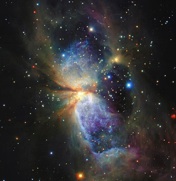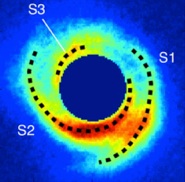Research Highlights

Stars and planets are the astronomical objects that have been observed in our history for the longest time. Understanding their formation mechanisms is one of the major challenges of contemporary astrophysics. Outstanding questions include: how do mass accrete onto stars?; which mechanism drives beautiful and collimated jets, and how these are related to mass accretion onto stars?; how do planets grow in protoplanetary disks?
Observations at multiple wavelengths are essential to investigate the entire process of star and planet formation, by observing gas and dust at a variety of temperatures. The existing optical-IR facilities are useful for observing warm gas (103 − 104 K) from the active regions, such as the jet/wind launching region, mass accretion flow to the protostar, and protoplanetary disks at the planet-forming radii. In contrast, observations at millimeter/sub-mm wavelengths allow us probe cold (<<100 K) gas and dust, i.e., the ingredients of star and planets. Together with young colleagues at ASIAA I have been tackling the above issues through observations at optical and infrared wavelengths.
Star Formation (Low-Mass)
Most of the stars in the universe are categorized as “low-mass stars”, whose masses are comparable to our Sun. Understanding the mechanism of mass accretion, and also the physical conditions which determine stellar masses, are two of the major challenges of star formation theories.
Mass accretion cannot proceed without removing excess angular momentum from the surrounding material. Some theories predict that the outflowing gas, which is often observed as beautiful optical jets and energetic molecular outflows, plays an important role in this process. However, the details of the physical link between mass accretion and ejection is not yet clear.


Observations at high-angular resolutions help us to understand what is going on close to the engine. The left images show jets and outflows observed using the Gemini-North telescope at a ~0”.1 resolution. The collimated jets in the iron emission show knotty structures probably due to episodic ejection of gas. The molecular hydrogen emission shows a remarkably different distribution, and this outflow component may be driven by a distinct wide-angled wind. Such a flow geometry agrees with the model predictions. The continuum emission is due to scattered light in the outflow cavity (Takami et al., 2007, ApJL, 670, 33; see also this article for a comprehensive summary).
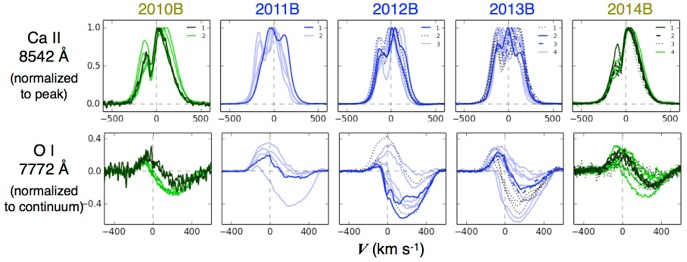
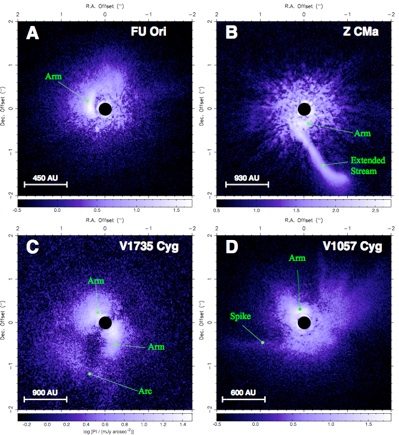
Some researchers think that the stellar masses may be developed by a sequence of accretion outbursts during their birth. Not many stars are found to be associated with such outbursts — only a dozen out of thousands. This may be simply because they are relatively quiet most of the time.
The left figure show circumstellar environments associated with “FU Ori-type objects”, which currently show accretion outbursts. Complicated circumstellar structures are seen as a number of dust particles in circumstellar material scatter infrared light from the region very close to the star (masked with a black circle for each image). These structures give useful hints about the mechanism to trigger accretion outbursts. This work was led by Dr. Hauyu Baobab Liu, one of my former postdocs (Liu, Takami et al. 2016, Science Advances, Vol. 2, No. 2, id.e1500875; see also the press release at Subaru Telescope).
Star Formation (High-Mass)
The number of high-mass (>8 Msolar) stars is much smaller than low mass stars, but outflows, winds and UV radiation associated with them significantly affect the evolution and formation of surrounding stars. The formation of high-mass stars represents another puzzle from a theoretical point of view. Once the protostars evolves, further accretion should be inhibited by radiation pressure and powerful stellar winds. However, it is difficult to observe the growth of high mass protostars and how mass accretion is going onto them. This is because these stars are very heavily embedded in dusty clouds, and thereby not directly seen at optical and infrared wavelengths. Regions are transparent at longer wavelengths, but such emission is associated with relatively cold gas and dust away from the protostars.
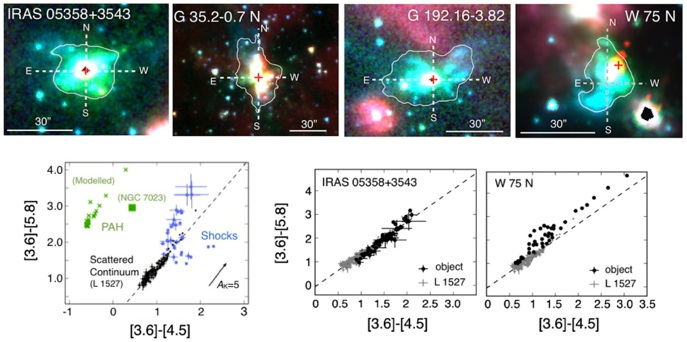
Planet Formation & Protoplanetay Disks
This exciting and active area for astronomical research has long fascinated many scientists. Nurseries of planets, namely protoplanetary disks, form and grow around young stars at a similar time scale to star formation.
Subaru Telescope, one of the largest optical-IR telescopes in the world, located at Mauna Kea, Hawaii, has been in the forefront of developing instruments designed for planet-hunting and observing protoplanetary disks. Its HiCIAO coronagraph developed in 2009 has produced an amazing ability to resolve the surface of protoplanetary disks. An international research team has used this instrument to perform a large survey of exoplanets and disks (the SEEDS project). A combination of HiCIAO’s unprecedented sensitivity and angular resolution has allowed us to reveal a variety of disk structures, such as spirals, holes, rings and gaps, which may be signposts for ongoing planet formation.
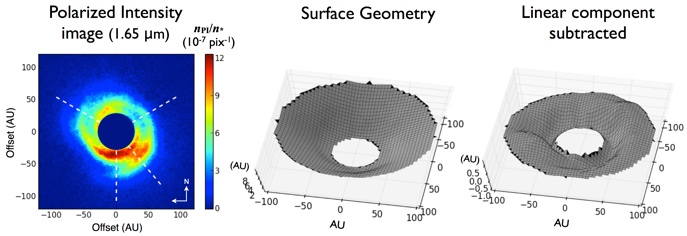

We have found a layer of dust almost transparent in the near infrared in the protoplanetary disk around the RY Tauri star which functions as a special baby duvet for forming planets (Takami et al. 2013, ApJ, 772, 145; see also this article for a comprehensive summary). As seen in the above image, the observed scattered light in this layer is offset from the midplane of the disk because of its vertical extension. This “duvet” may affect the number, size, and composition of the planets being born in this system (see this page for a press release). The simulation code was developed with Drs. Jennifer Karr and Hyuson Kim, my colleagues at ASIAA (the Sprout code).

Jerome de Leon, one of my former summer students, worked on data reduction and analysis for HiCIAO data of SU Aur, one of well-studied T Tauri stars. We have found that the protoplanetary disk toward this object (the bright region in the above figure) is associated with odd tails. The entire morphology reminds us of interacting galaxies, and we speculate that these tails result from tidal interaction with an unseen object like a brown dwarf. Such an interaction may have triggered violent mass accretion onto the star. This physical process may simultaneously affect structures and kinematics of the protoplanetary disk, and therefore the initial stage of planet formation (de Leon, Takami et al. 2015, ApJ, 806, L10).
Last updated in May 2016



(Low-mass)
See below
